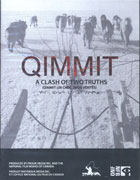
Qimmit: A Clash of Two Truths 2010
Distributed by National Film Board of Canada, 1123 Broadway, Suite 307, New York, NY 10010; 800-542-2164
Produced by Piksuk Media Inc., the National Film Board of Canada, Joe MacDonald and Charlotte De Wolff
Directed by Ole Gjerstad and Joelie Sanguya
DVD, color, 68 min.
Jr. High - General Adult
Animal Behavior; Animal Rights; Anthropology; Asian Studies; Canadian Studies; Environmental Studies; Native American Studies
Date Entered: 08/22/2012
Reviewed by Caron Knauer, La Guardia Community College, Long Island City, New YorkThe Inuit, who live on the Clyde River in the southern arctic Canadian province of Nunavet, are the focus of this convincing documentary. From the 1950s until the late 1960s, the Inuit were forced to abandon their nomadic lifestyle when they were moved by the government into settled communities. During this time, the natives contend, close to 20,000 of their beloved sled dogs, so integral to their survival and culture, were slaughtered by the Royal Canadian Mounted Police (RCMP), members of who categorically deny wrongdoing. Documents and archives, they claim, support their innocence. Nowhere is it written that dogs should or would be killed.
Retired policemen claim that their repeated demands that the Inuit tie up their dogs often went unheeded, and they do admit to frustration about the dogs. Some speak of an unwritten mandate to destroy any loose dogs near the settlement, but how that mandate or law was applied, an Inuit says, depends on to whom you talk. A white man talks about how Ski-Doos, or snowmobiles, replaced the dogs as a mode of transportation, rendering them unnecessary. Such a deterministic point of view does not take into account respect for Inuit tradition. One Inuit admits to being paid by the white policeman to shoot and dispose of the dogs, and another dog handler talks about being caught between the authorities who wanted the dogs shot and their owners who did everything they could to prevent that. Interviews with older Inuit are juxtaposed with interviews of retired policeman, one of whom talks about not wanting to have the guilt of being a dog killer on his conscience.
Still photographs, the occasional voice over, exterior shots of the snowy, icy landscape, and atmospheric Inuit music enhance the series of interviews, many of which are emotionally wrenching. Most Inuit speak their native language, so subtitles are provided. The oral tradition tells the story of corrosive, destructive racism, while the written record of the whites is stained by its sin of omission. One older Inuit, Jamesie Mike, questions why the policeman who shot his dog didn’t warn him first, saying, “Maybe he thought I was nobody, not human.” And while his people no longer depend on sled dogs for their survival, the dogs, happily, are making a comeback, offering hope for reconciliation.
Awards
- Rigoberta Menchu Second Prize, First Peoples' Festival (Land In Sights)